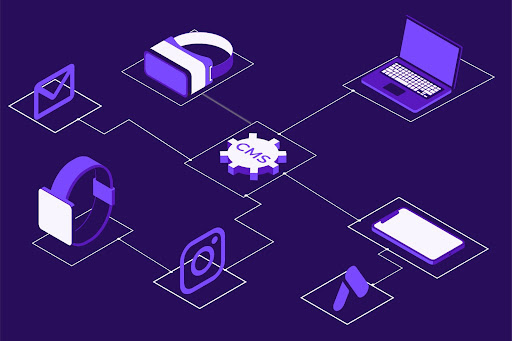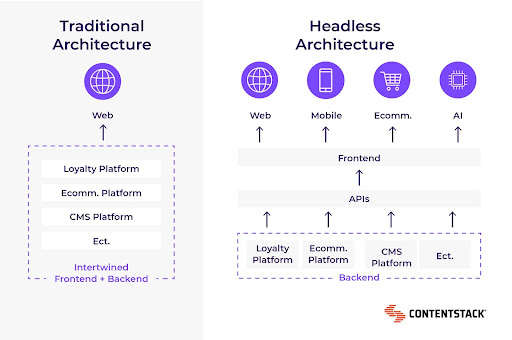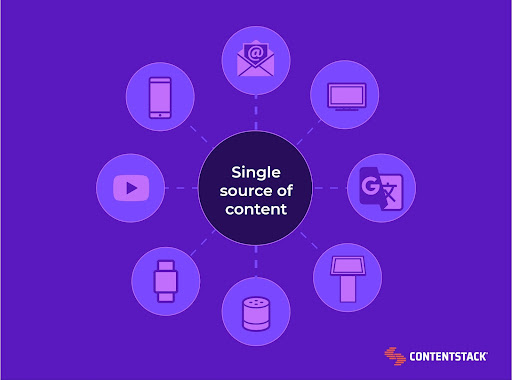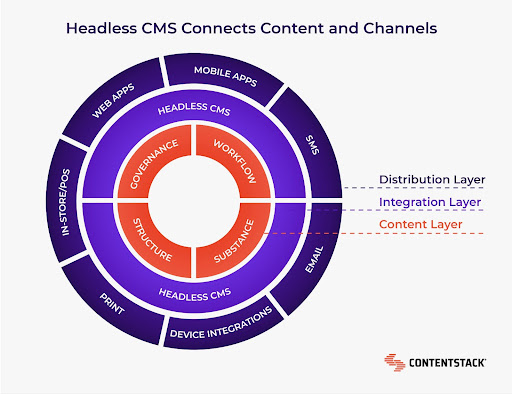Are you ready to make the switch from a traditional legacy content management system to a modern headless one? Use this guide from the pioneers in headless content management to learn the ins and outs of headless content tech, which core elements to shop for and how to leverage headless to improve your everyday workflows.

What Is a Headless Content Management System?
A headless content management system (CMS) is a software platform where content assets are created, managed and organized by marketers in a back-end repository. This back end functions separately from the front-end display layer, where designers and developers create the interfaces that serve content to consumers. Application programming interface (API) technology allows the front end and back end to work together, distributing content anywhere and everywhere you need it — to your smartwatch app, your different company websites in various languages, your customer relationship management (CRM) platform, your 5,000 in-store kiosks across the country and far beyond.

A Brief History of the Headless Content Management System
In the early years of the internet, the CMS emerged as an essential tool that allowed businesses to manage their websites more easily. Some of the very first content management tools of note were Vignette’s StoryServer and IBM’s FileNet (which still exists today). These CMSes excelled at the creation of websites, firmly establishing the web as the world’s first digital channel and CMSes as the vehicles for distributing digital content to growing online audiences.
Shortly after that, blogging became popular. And with it, so did some of today’s still well-known CMSes such as Drupal and WordPress. They established WYSIWYG (“what you see is what you get”) editing as a leading content management system feature because it allows faster website creation and quick content publishing. However, traditional CMSes confront an existential challenge in today’s fast-moving digital landscape.
Connected devices have driven an explosion in the number of channels, screens and formats for content. Any piece of content can be restructured and redeployed in hundreds of contexts across myriad devices today. WYSIWYG editors are just not built to handle this level of complexity. Traditional, legacy CMS solutions only handle 1:1 content deployment to a single, static web page. These systems can't keep up with the omnichannel world of mobile sites, smart billboards, touchscreen displays, Alexa integrations and smartwatch apps.
All of this presents a challenge for organizations using 20-year-old content management system technology. Where once it was advantageous to optimize for a single digital channel, now this highly streamlined CMS architecture is insufficient for a world in which content has to be available on many digital channels. From a technical perspective, the old model of intermingling content with the instructions for how to present it (i.e., HTML, CSS, JavaScript, etc.) falls short. Using this model, you can’t limit or control content because you don’t know where your digital content is going to surface next.
However, the core elements of a headless CMS enable businesses to create content once and publish it anytime, anywhere in a world where competitors move fast and consumer demands even faster.
Click here to keep learning about the rich history of content management systems.
Core Elements of an Effective Headless CMS
There is a core set of features that define today’s most enterprise business-friendly headless CMS platforms.
API Connectivity
A good headless CMS runs on APIs. Enabling different applications to work together, APIs create the flexibility and scalability that make all other headless CMS features possible. To learn more about what APIs are, what they do and how to make sure any headless CMS has what you need, be sure to read “Having an API Doesn't Make Your CMS Headless.”
Microservices Architecture
Microservices are lightweight applications that, when connected via API, can be strung together to create some very large and very functional software systems. Because they are not intertwined, microservices can be swapped out and updated as needed to keep entire systems functional with minimal risk, expense or downtime. Microservices are the building blocks of many of today’s cutting-edge tools and modern headless CMSs are no exception. Learn more about them from our article “Microservices: The Ultimate Guide.”
Content Modeling and Modules
Content assets are created and stored in content “modules” inside headless CMS platforms. Content modeling is the process of naming and describing the relationships between these modules. A headless CMS with a business user-friendly interface should enable marketers to create and edit content modules and build out content models so that content can quickly be re-optimized and re-published to various channels.
Simplified Integration Workflow
Because they’re built on a thoughtful web of API-connected microservices, headless CMSes are easy to integrate new tools into. That means developers and designers can use the tools they need to keep the back end and consumer experiences up to date. It also means your tech team can connect the top-of-the-line marketing tools that enable you to serve the localized, personalized and optimized campaigns that consumers crave.
Easy-to-Use Interface
Not all headless CMS platforms have a marketing-friendly interface. If you have a large content marketing team that needs to work autonomously and at a quick clip, you should prioritize one that does. Look for an interface with features like real-time content editing previews, workflows that automate the publishing process, roles and permissions that protect content security and accuracy, versioning and rollbacks and so on.
Headless CMS vs. Alternative Platforms
There’s a lot of lingo to learn in the content management and marketing worlds. Here, we explain some common terms and platforms you’ll encounter on your headless CMS journey.
Headless CMS vs. Traditional CMS
Traditional CMSs are monolithic. The back end and front end are intertwined on a technological level. This means that content can only be created and then published once to a specific digital instance such as a static website page. Each piece of content is integrated with the interface upon which it’s served, so it cannot be re-optimized or re-published for different audiences or channels. This was ideal when brand websites were a budding concept, but today it’s a hindrance for marketers who need to reuse content campaigns and designers and developers who need to use modern tools and languages to serve these campaigns.
Traditional CMS is the technology from which headless CMS evolved when omnichannel marketing hit the scene and content flexibility became a must-have.

Headless CMS vs. Hybrid CMS
A hybrid CMS is basically a headless CMS that still has a front end. For marketers, it can look and function much like a traditional CMS, but for developers it offers multiple APIs with which they can work to serve content on different digital channels. While this offers a solution for businesses that don’t have the technical chops to go fully headless, it does come with some downsides. Just like with traditional monolithic CMSs, hybrid CMSs suffer from front-end inflexibility, lack the content modeling and modules that make omnichannel publishing approachable, feature complex code that can hinder microservice integrations and more.
Headless CMS vs. DXP
The headless CMS is quickly becoming a crucial component of something called the digital experience platform (DXP). DXPs go significantly beyond content management to help create immersive, engaging experiences for audiences across a multitude of channels. Learn more about the digital experience platform concept and why headless CMS is a foundational element to its success in our guide, “What Is a DXP? Understanding Digital Experience Platforms.”
Benefits of Headless CMS
The headless CMS offers significant benefits for firms that are growing into new channels, launching new products and integrations, or simply transacting with customers across a range of touchpoints on multiple platforms and devices.
Modern Headless CMS Drains Less Time and Budget
Instead of having to implement multiple, parallel content management system instances to support various digital channels, a single headless CMS instance can serve unlimited digital channels. With headless CMS, you will sink less of your budget into technology upkeep and workers will spend less time switching between outdated systems to build out marketing campaigns.
Improve Morale with Ease of Use
The separation of code and content in a headless CMS makes life easier for content editors. Developers, meanwhile, can use all the latest tools and frameworks to bring content experiences to life on any modern platform, without being locked into a proprietary language or other limitations of a particular content management system.
Maintain Content Accuracy and Security with a Single Source of Truth
If your company makes an update to the way it describes a product, that update shouldn’t be copied and pasted in 20 different systems. You should be able to make the update in one centralized location and push the change out to all of the places where it matters. That’s the power of a headless CMS.
The headless CMS works as one central source for all of your company’s content and assets. It gives you one place to manage, edit, update, publish and control access to all of your content. When you go headless, a single source of content — such as a product description for an online catalog — can automatically adapt to its publishing environment and present itself optimally for its destination.

Save Time by Reusing Modular Content Assets
Because the content that lives in your headless CMS isn’t dependent on any specific front-end display, content becomes modular. Modular content can be managed and deployed across any relevant touchpoint without duplicating or reformatting it from scratch.
Deliver the Omnichannel Content Experience Consumers Demand
The headless CMS is an essential piece of technology because we live in an omnichannel world. The content that enterprises create for their websites also needs to appear on apps, integrations, email newsletters and more.With headless CMS, content lives in a cloud-first content hub, so deployment is simple and fast. A headless CMS can power content-based experiences across any channel or device – from websites to mobile apps, email marketing, voice-activated digital assistants, Apple Watch, AR/VR and more.
Get to Market Faster with Rapid, API-First Content Deployment
A modern headless CMS offers an API-first approach that makes it lightning-fast for developers to pipe in content. Content delivered via APIs is significantly easier to integrate, manipulate and distribute, reducing the time it takes to create content-driven experiences, including sites and apps.
Limitless Integrations Power Personalization and More
Headless CMS software allows enterprise users to connect content to a nearly infinite array of outside services. Your content is no longer siloed from systems like CRM, AI/ML, personalization tools, or localization platforms when you’re powered by headless tech.

See Headless CMS Use Cases in Real-Life
Many enterprise organizations across industries are embracing headless CMS as a foundational element that powers their entire digital experience across all devices and platforms. Headless CMS allows companies to connect with customers at scale, respond quickly to emerging market opportunities and streamline content operations to enforce consistency while remaining agile.
Some of the top industries and enterprises taking advantage of headless CMS include:
Professional Sports Teams
Powered by a headless CMS, pro sports teams are able to build omnichannel fan engagement platforms. By marrying content with personalized data, teams can help fans feel more connected than ever to the players they love most.
See it in action: “Miami HEAT Delivers Realtime Personalized Digital Experiences with a Headless CMS”
Airlines
Airlines face some of the most complex content requirements of any industry. Their teams manage real-time communications, global content translation and localization and an omnichannel presence that spans hundreds — if not thousands — of individual customer touchpoints. Across owned web properties, mobile apps, email, third-party search sites and physical displays, a headless CMS enables clear, consistent and simplified communications that are always up to date.
See it in action: “Icelandair Irons out Integration Issues and Improves Automation and Workflows by Moving to a Headless CMS”
Financial Services
In the financial service sector, customers rely on real-time content to inform some of their most important choices. They also demand personalized content that helps them navigate complex processes and make smarter financial decisions. With headless CMS, financial firms have access to the flexibility they need to innovate, the reliable foundation they need to securely manage content and the integrations they need to provide personalization at scale.
See it in action: “Ellie Mae Increases Content Delivery and Decreases Development Costs with a Headless CMS”
Online Retailers
In online retail, the customer experience is king. Customers are quick to criticize brands that fail to meet their needs or introduce the tiniest amount of friction into the buying process. A headless CMS allows online retailers to form 1:1 connections with customers, tying marketing and product content into customer data to deliver a truly personal shopping experience at scale.
See it in action: “PhotoBox Streamlines Content Publishing with Contentstack’s Powerful APIs”
Beyond these verticals, at Contentstack we’ve seen many more companies successfully deploy headless CMSs to build modern tech stacks that marry flexibility with speed and innovation with security and reliability.
Future-Proof Your Business with Headless CMS
On a steady basis, new channels, new competitors and new consumer expectations are formed. Ready your teams, your workflows and your content for the future with better tools and more knowledge. You can try a modern headless CMS for yourself right now to see if it’s the right tool for you. And to keep deepening your knowledge, we invite you to check our guides, which cover every kind of content management system as well as key concepts like microservices, digital transformation, enterprise marketing, omnichannel content management and so much more.
Related Articles
Here are some CMS articles we think you'll find useful.
Headless CMS Survey Results: Taking a New and Improved Approach to Content Delivery
Delivering seamless digital experiences across the touchpoints of the customer journey is tough. This Gartner report explains why “application leaders in charge of customer experience should implement a composable user experience aligned with specific personas.”
Read more
How Headless CMS Delivers Content and Digital Experiences to Customers
Learn about headless CMS industry trends, real-world use cases, and CMS implementation best practices, and how enterprises can support a multitude of digital experiences with an API-first CMS architecture.
Read more
Content and the Omnichannel Digital Experience
Here's everything you need to know about new consumer expectations and how to scale to meet them without sacrificing the quality and consistency that your audience has come to trust.
Read more
